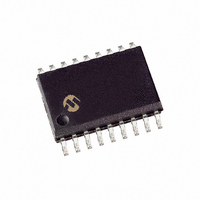PIC16LF84-04/SO Microchip Technology, PIC16LF84-04/SO Datasheet - Page 41

PIC16LF84-04/SO
Manufacturer Part Number
PIC16LF84-04/SO
Description
IC MCU FLASH 1KX14 EE 18SOIC
Manufacturer
Microchip Technology
Series
PIC® 16Fr
Specifications of PIC16LF84-04/SO
Core Size
8-Bit
Program Memory Size
1.75KB (1K x 14)
Core Processor
PIC
Speed
4MHz
Peripherals
POR, WDT
Number Of I /o
13
Program Memory Type
FLASH
Eeprom Size
64 x 8
Ram Size
68 x 8
Voltage - Supply (vcc/vdd)
2 V ~ 6 V
Oscillator Type
External
Operating Temperature
0°C ~ 70°C
Package / Case
18-SOIC (7.5mm Width)
Controller Family/series
PIC16LF
No. Of I/o's
13
Eeprom Memory Size
64Byte
Ram Memory Size
68Byte
Cpu Speed
4MHz
No. Of Timers
1
Lead Free Status / RoHS Status
Lead free / RoHS Compliant
Data Converters
-
Connectivity
-
Lead Free Status / RoHS Status
Lead free / RoHS Compliant, Lead free / RoHS Compliant
Other names
PIC16LC84A-04/SO
Available stocks
Company
Part Number
Manufacturer
Quantity
Price
Company:
Part Number:
PIC16LF84-04/SO
Manufacturer:
ON
Quantity:
34 000
FIGURE 8-6:
8.2.4
For timing insensitive applications the RC device option
offers additional cost savings. The RC oscillator
frequency is a function of the supply voltage, the
resistor (Rext) values, capacitor (Cext) values, and the
operating temperature. In addition to this, the oscillator
frequency will vary from unit to unit due to normal
process
difference in lead frame capacitance between package
types also affects the oscillation frequency, especially
for low Cext values. The user needs to take into
account variation due to tolerance of the external
R and C components. Figure 8-7 shows how an R/C
combination is connected to the PIC16F8X. For Rext
values below 4 k , the oscillator operation may
become unstable, or stop completely. For very high
Rext values (e.g., 1 M ), the oscillator becomes
sensitive to noise, humidity and leakage. Thus, we
recommend keeping Rext between 5 k and 100 k .
Although the oscillator will operate with no external
capacitor (Cext = 0 pF), we recommend using values
above 20 pF for noise and stability reasons. With little
or no external capacitance, the oscillation frequency
can vary dramatically due to changes in external
capacitances, such as PCB trace capacitance or
package lead frame capacitance.
See the electrical specification section for RC
frequency variation from part to part due to normal
process variation. The variation is larger for larger R
(since leakage current variation will affect RC
frequency more for large R) and for smaller C (since
variation of input capacitance has a greater affect on
RC frequency).
See the electrical specification section for variation of
oscillator frequency due to V
values as well as frequency variation due to
operating temperature.
The oscillator frequency, divided by 4, is available on
the OSC2/CLKOUT pin, and can be used for test
purposes or to synchronize other logic (see Figure 3-2
for waveform).
1998 Microchip Technology Inc.
74AS04
330 k
RC OSCILLATOR
parameter
0.1 F
XTAL
EXTERNAL SERIES
RESONANT CRYSTAL
OSCILLATOR CIRCUIT
74AS04
330 k
variation.
DD
74AS04
for given Rext/Cext
Furthermore,
To Other
Devices
PIC16FXX
CLKIN
the
FIGURE 8-7:
8.3
The PIC16F8X differentiates between various kinds
of reset:
• Power-on Reset (POR)
• MCLR reset during normal operation
• MCLR reset during SLEEP
• WDT Reset (during normal operation)
• WDT Wake-up (during SLEEP)
Figure 8-8 shows a simplified block diagram of the
on-chip reset circuit. The MCLR reset path has a noise
filter to ignore small pulses. The electrical specifica-
tions state the pulse width requirements for the MCLR
pin.
Some registers are not affected in any reset condition;
their status is unknown on a POR reset and unchanged
in any other reset. Most other registers are reset to a
“reset state” on POR, MCLR or WDT reset during
normal operation and on MCLR reset during SLEEP.
They are not affected by a WDT reset during SLEEP,
since this reset is viewed as the resumption of normal
operation.
Table 8-3 gives a description of reset conditions for the
program counter (PC) and the STATUS register.
Table 8-4 gives a full description of reset states for all
registers.
The TO and PD bits are set or cleared differently in dif-
ferent reset situations (Section 8.7). These bits are
used in software to determine the nature of the reset.
Cext
V
Recommended values: 5 k
Rext
Note:
SS
V
DD
Reset
When the device oscillator is in RC mode,
do not drive the OSC1 pin with an external
clock or you may damage the device.
Fosc/4
RC OSCILLATOR MODE
OSC1
OSC2/CLKOUT
Cext > 20pF
PIC16F8X
Rext
DS30430C-page 41
100 k
PIC16FXX
Internal
clock














